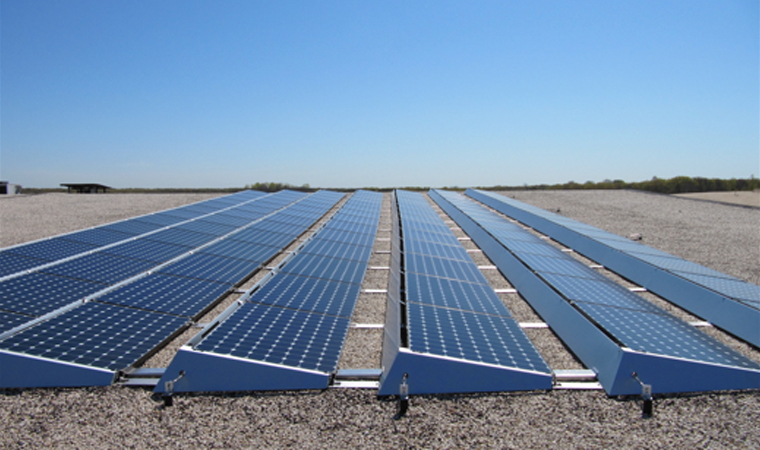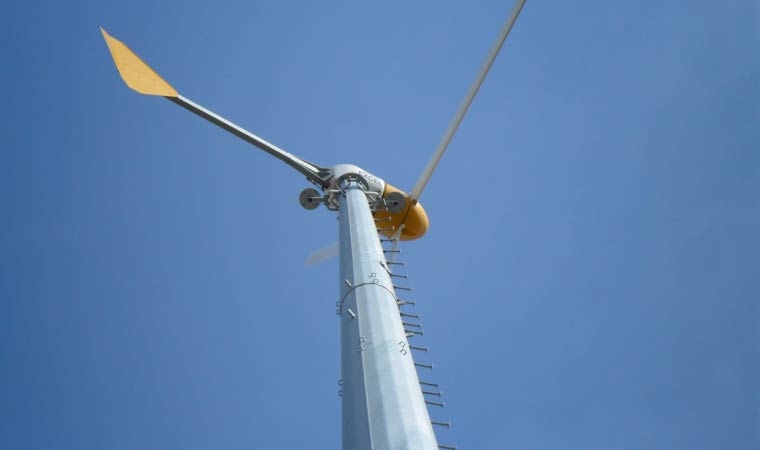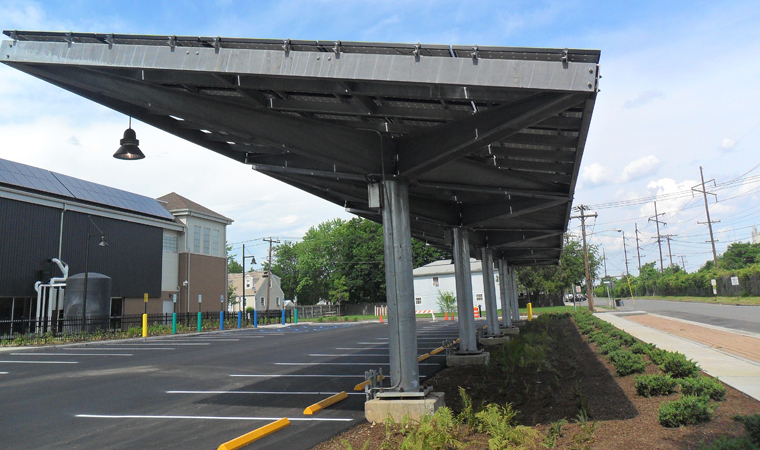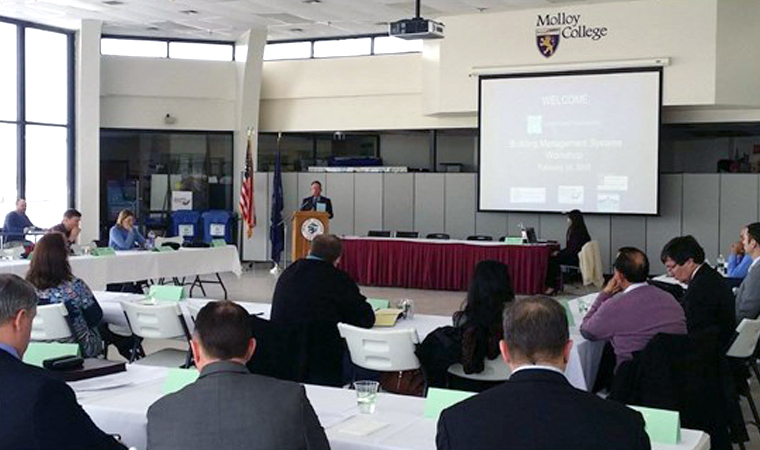- Town of Smithtown Solar Photovoltaics
- Smithtown Wind Turbine
- “Yes We Can” Community Center
- NYSERDA/Climate Smart Communities

Town of Smithtown Solar Photovoltaics
Smithtown, NY
Show Project Details
Cameron Engineering performed an electrical and structural analysis, electrical design and construction observation services for the integration of a 50,000 watt solar photovoltaic system to the existing Smithtown municipal recycling facility and administration infrastructures.
The designed solar photovoltaic system included a 48,000 watt roof-mounted and 2,000 watt pole-mounted mono-crystalline solar sub-systems. These systems were designed and implemented to reduce the billable electrical usage of the facilities and as a platform for public education services.
The facility’s solar photovoltaic sub-systems include a web based flat screen monitoring system that displays system performance parameters such as, current and past solar irradiation levels, ambient and solar module temperatures, system power output, voltage and current levels, system efficiency, wind speed and trend analysis line graphs. This display platform includes additional renewable energy educational information for public display.

Town of Smithtown Wind Turbine
Smithtown, NY
Show Project Details
Design of a 10kW horizontal-axis, direct drive wind turbine with an associated 120’ self-supporting lattice tower. With an estimated wind speed of 11.5 mph at 120’, the wind turbine was forecasted to provide 11,220 kWh of annual power which equates to a savings of $2,100 per year. This wind turbine system was incorporated with an existing 50kW solar photovoltaic system to offset the Municipal Services Facility (Recycling Center) annual power consumption by an estimated amount of 75,000 kWh or, approximately $14,000 per year. The wind turbine system typical life expectancy is 30 years. During 30 years of operation, the wind turbine will offset 300 tons of Carbon Dioxide; 3,200 lbs. of Sulfur Dioxide, and 1,000 lbs. of Nitrogen Oxides. Significant utility based energy efficiency rebate funds were obtained to construct the new wind turbine system.
- Numerous electrical distribution system integration points
- Structural analysis of the existing roof structures
- Three-phase voltage integration
- State-of-the-art data transmission and display technology

Town of North Hempstead “Yes We Can” Community Center
New Cassel, NY
Show Project Details
The Town of North Hempstead completed a $28-million, 62,000-square-foot community center to provide modern-day services to their growing population. The state-of-the-art, 62,000 square foot facility features two NBA-sized basketball courts, fitness center, dance and TV studios, senior and teen lounge, internet café, community meeting rooms and much more. The new Community Center is among the most energy efficient buildings in New York State. The platinum LEED (Leadership in Energy and Environmental Design) certified structure, features roof-top solar panels, grade-level solar trees, electric vehicle recharging stations and geothermal heating and cooling. The North Hempstead “Yes We Can” Community Center, located in New Cassel, was partially funded by the American Recovery and Reinvestment Act as well Neptune Regional Transmission System.
The construction of the building required new energy efficient M/E/P systems consistent with the planned use of the interior spaces. Extensive coordination was required to incorporate the functionality of the systems into the constraints and limitations of the building structure while maintaining compliance with the Platinum LEED guidelines.
The key sustainable features of the facility include the following systems:
- Geothermal Hybrid chiller/boiler & Hybrid HVAC system
- “Solar Wall” provides passive outside air tempering
- Energy recovery ventilators
- Integrated HVAC and lighting controls utilizing occupancy sensors, CO sensors, photo-electric sensors to provide daylight harvesting and optimize energy performance
- “Grey Water System” – first approved installation in Nassau County
- Solar hot water heating system
- “Solar Trees” carport and photovoltaic rooftop installation
- Rain water harvesting/irrigation system
The energy savings provided by the building management and will reduce operational costs and the impact the building will have on the local utility grid.
The ventilation system design provides ventilation rates in accordance with the requirements of the New York State Mechanical Code with the ability to reduce ventilation rates when areas are not occupied using CO detection as a proxy to measure occupancy, as per ANSI/ASHRAE Standard 62.1-2004 “Ventilation for Acceptable Indoor Air Quality.”

NYSERDA/Climate Smart Communities
Long Island, NY
Show Project Details
Cameron Engineering with the Sustainability Institute of Molloy College is the Climate Smart Communities (CSC) Coordinator for Long Island. As an initial step, Cameron Engineering is assisting the New York Institute of Technology complete a comprehensive regional greenhouse gas (GHG) emissions inventory for Long Island. The inventory will serve as a benchmark by which municipalities will measure the efficacy of CSC efforts.
The Team is charged with developing and implementing a Regional CSC Plan. The plan sets the stage for engaging Long Island’s counties, towns, and villages on climate issues and securing their participation in the Climate Smart Communities (CSC) program.
The Team is identifying Climate Smart Communities most likely to implement successful climate action programs and providing direct and indirect support to their actions. We are working to increase the number of pledges throughout the region, and encouraging local governments to commit to active engagement in projects. The project includes meeting with participating and candidate municipalities to help them set priorities for GHG reductions and develop a plan to lower GHG emissions. Dissemination of information via mail, email, internet, events and one-on-one meetings are planned. In addition, presentations at events attracting the target audience will help to publicize the program.
For Long Island’s existing and new CSC communities we will be assessing the status of climate actions and assisting in planning climate actions. This includes training, information, guidance and direct assistance with defining potential energy use reductions, identifying land use and transportation changes and zoning modifications that could result in reduced emissions and consideration of measures to accommodate rising seas. A major goal is to assist CSC Communities in identifying and overcoming barriers that prevent implementation of climate actions. Once the regional GHG inventory is completed, the team will assist local municipalities in developing GHG Inventories and local climate action plans and identifying successful anchor projects that have the potential to be replicated in other municipalities.

